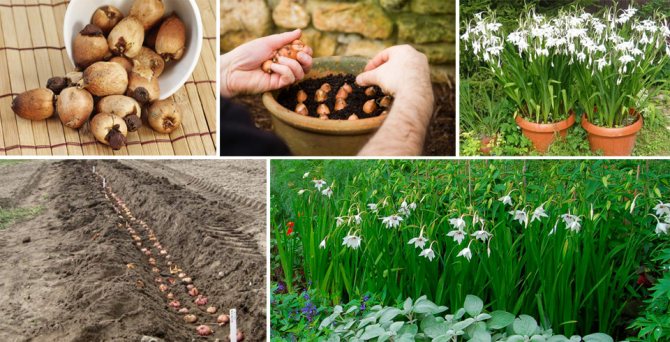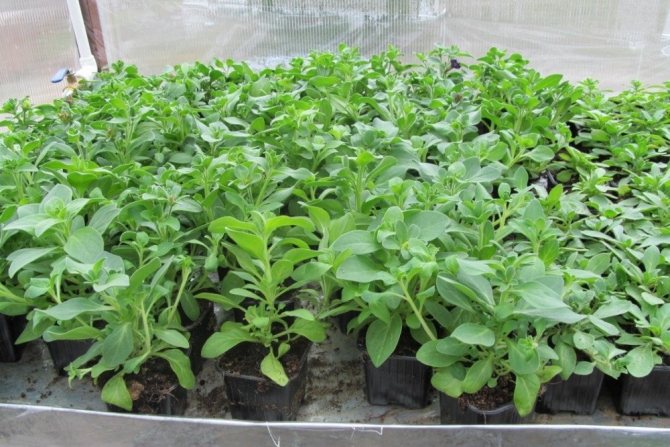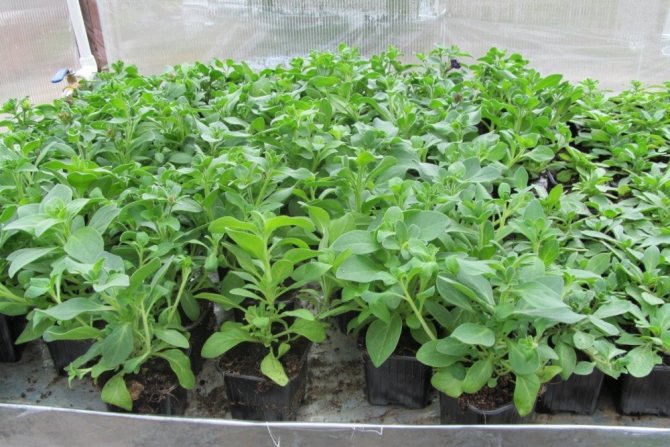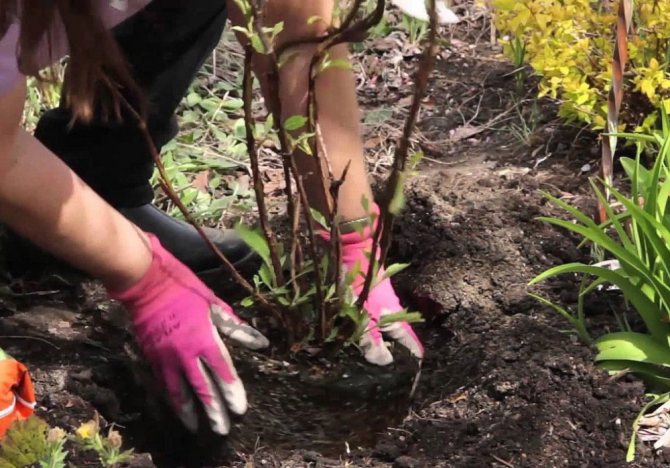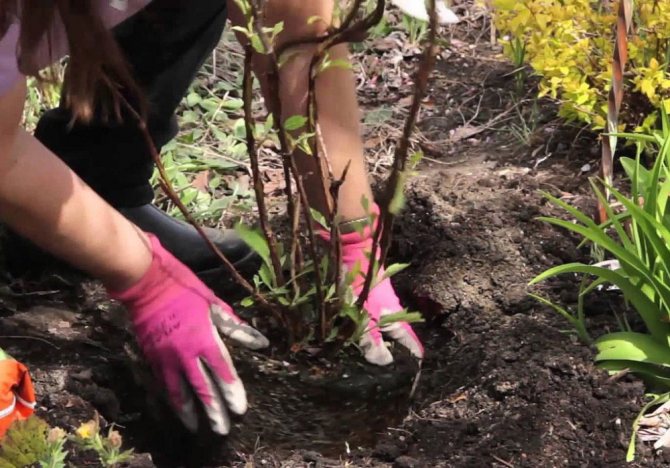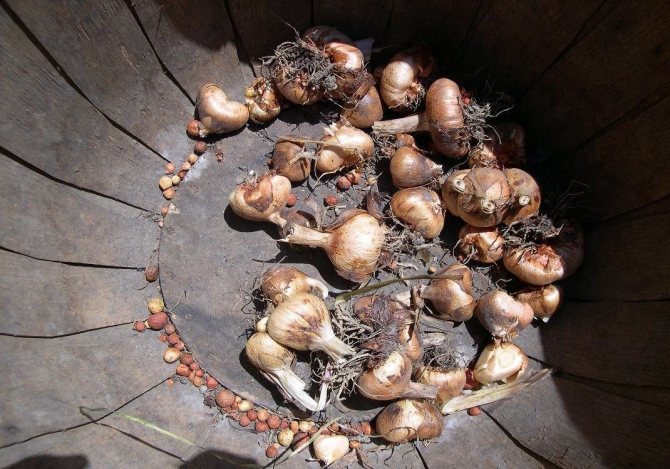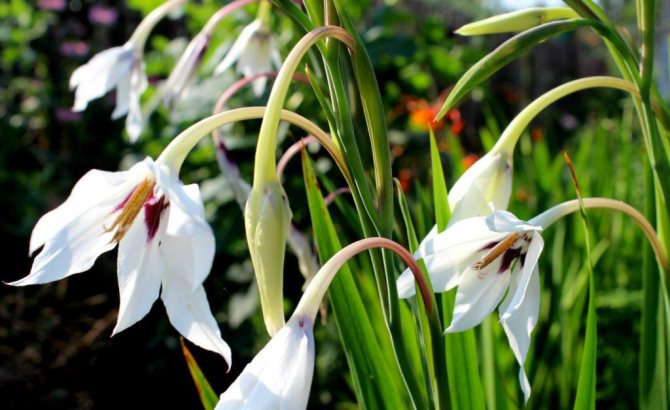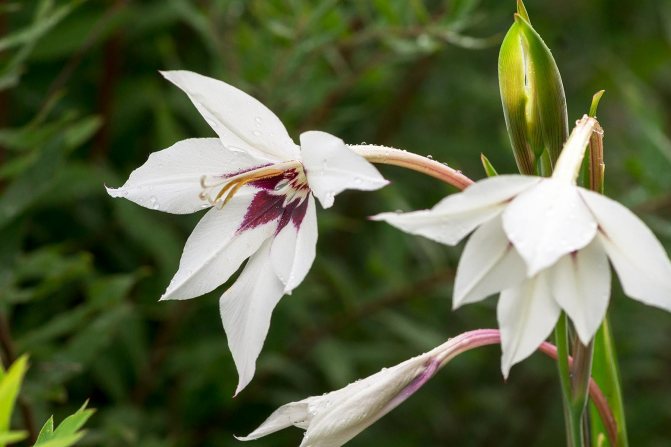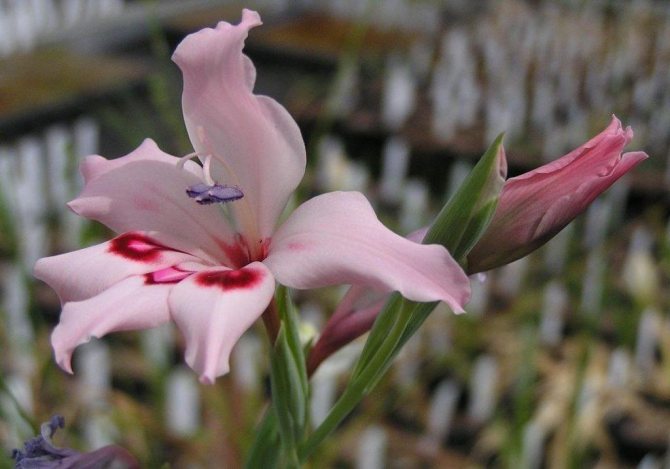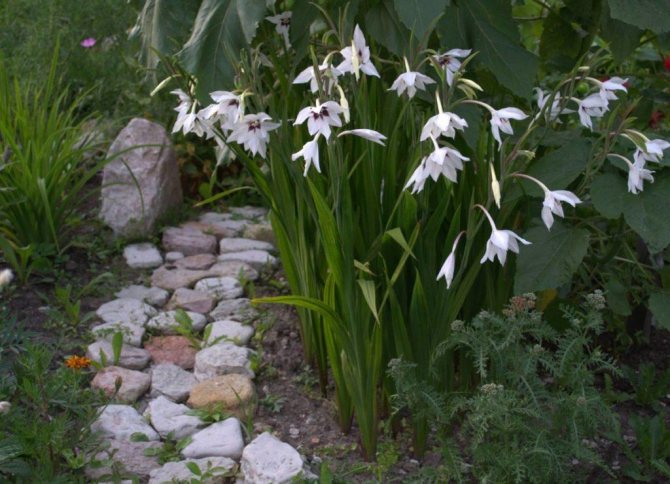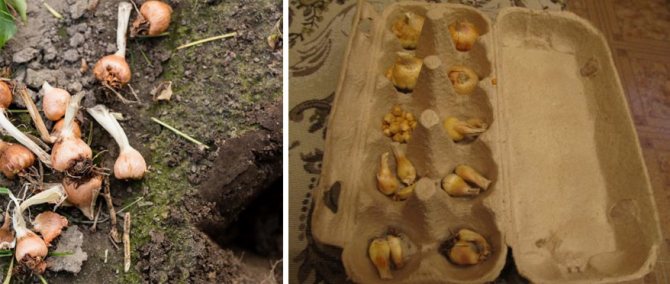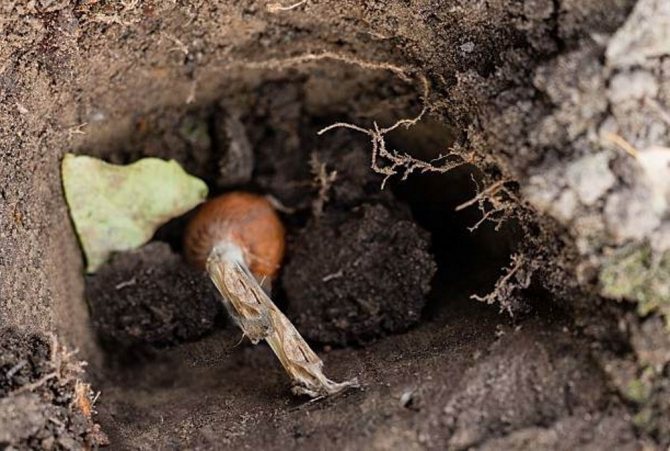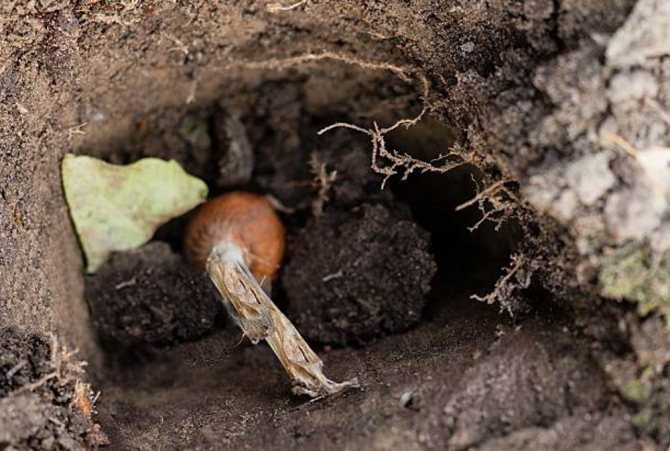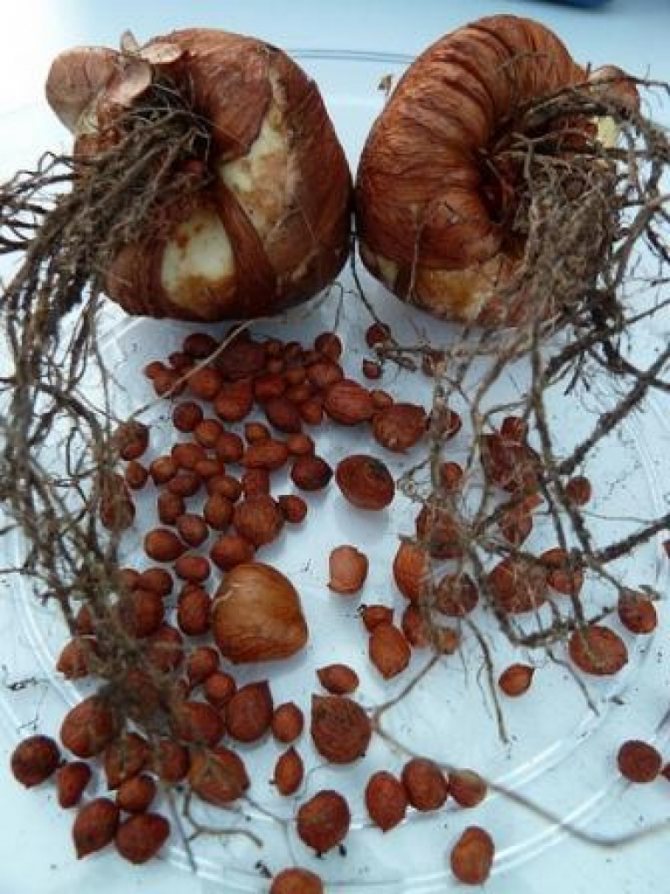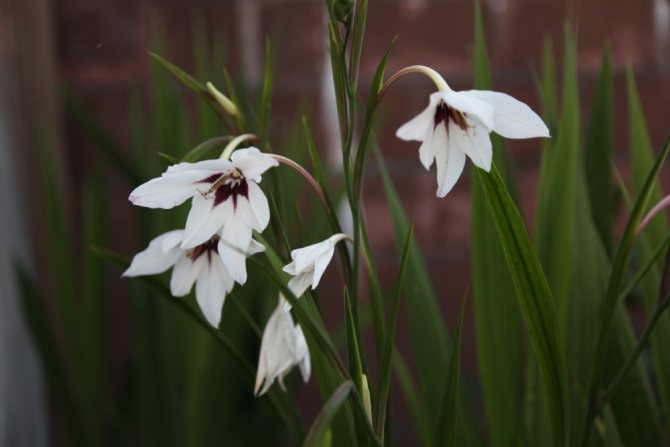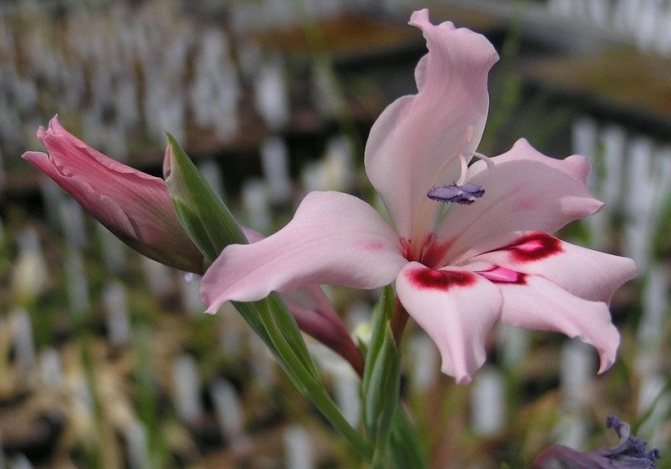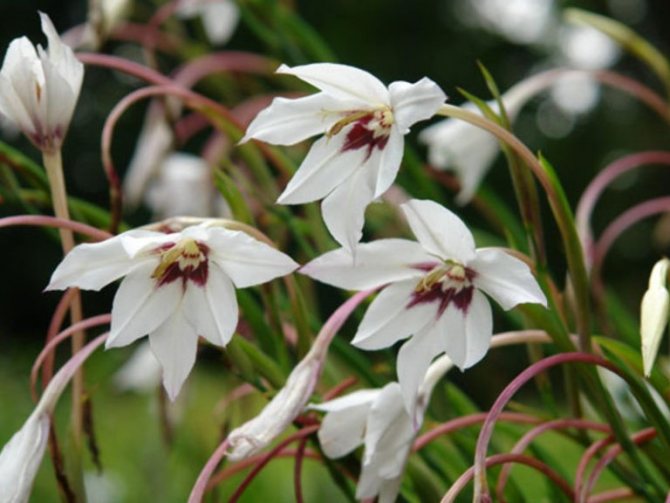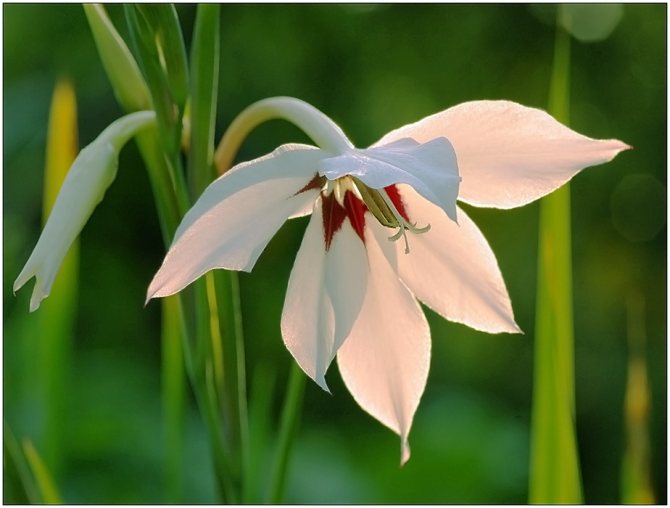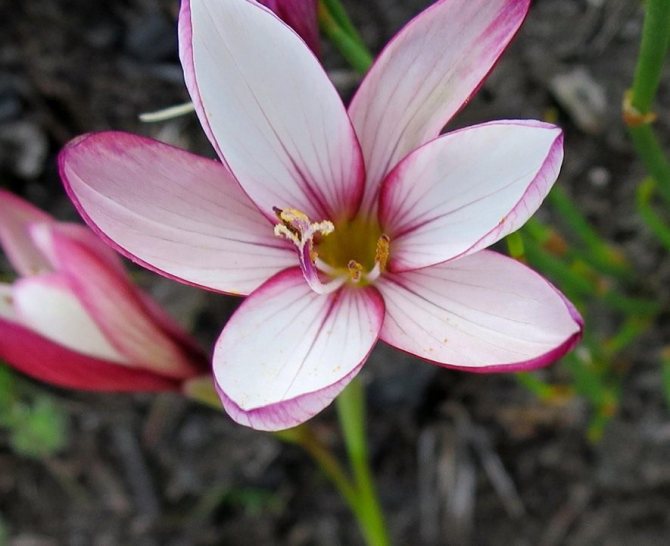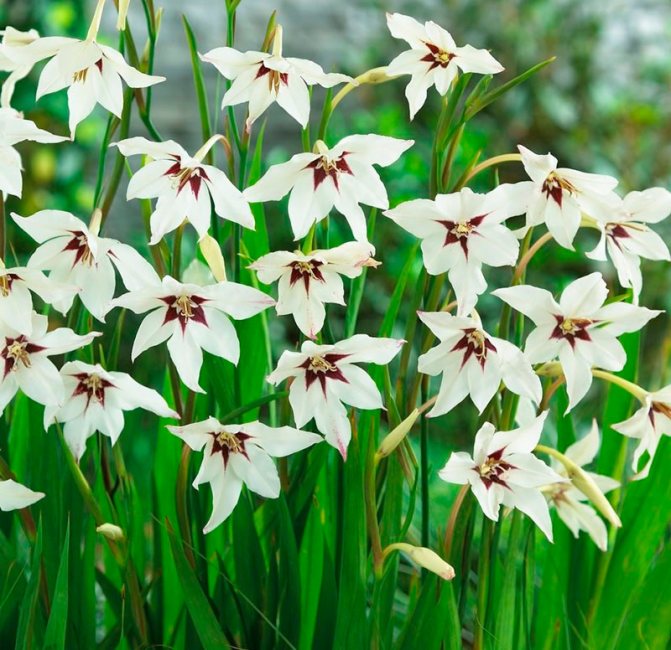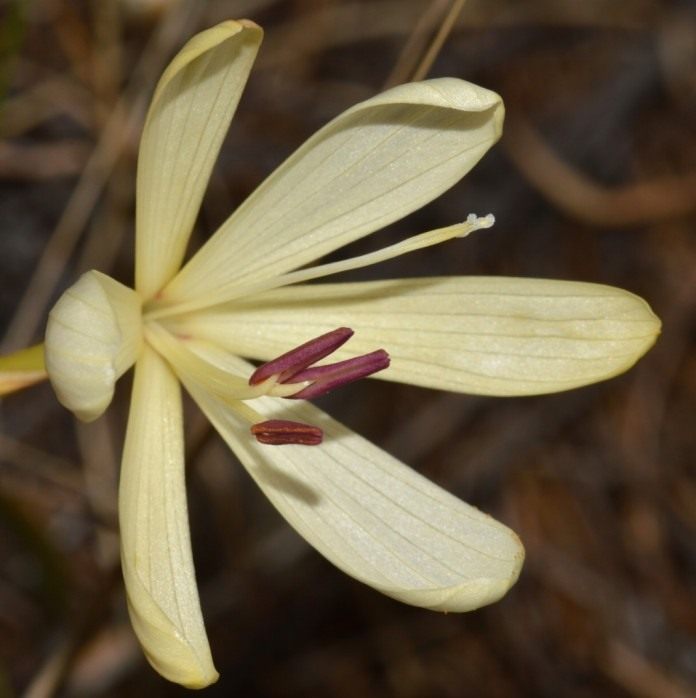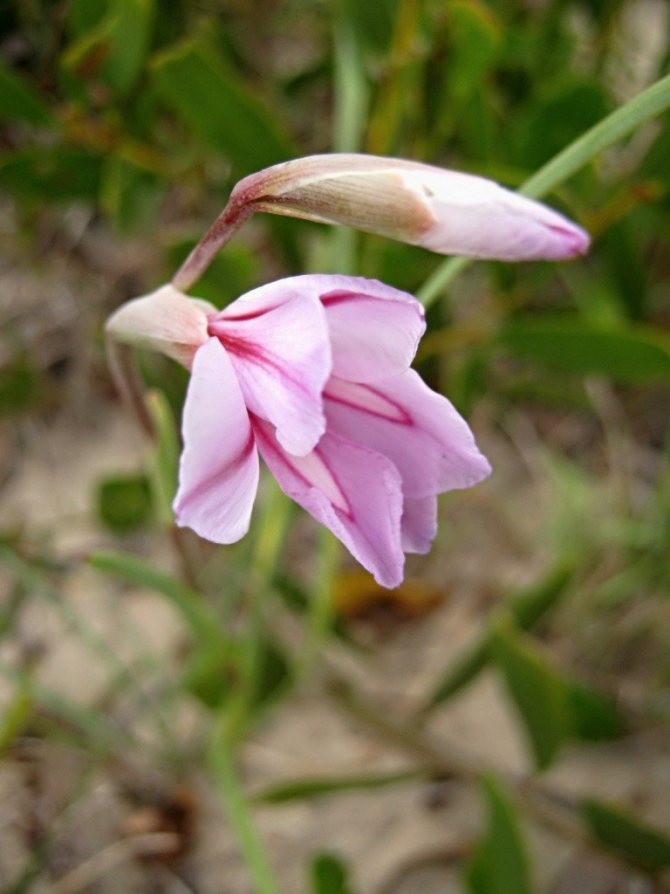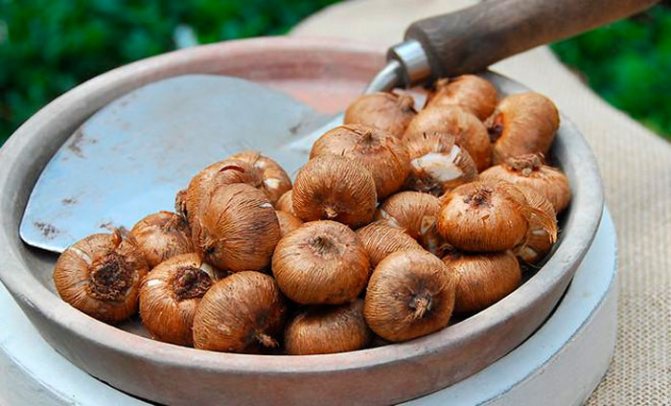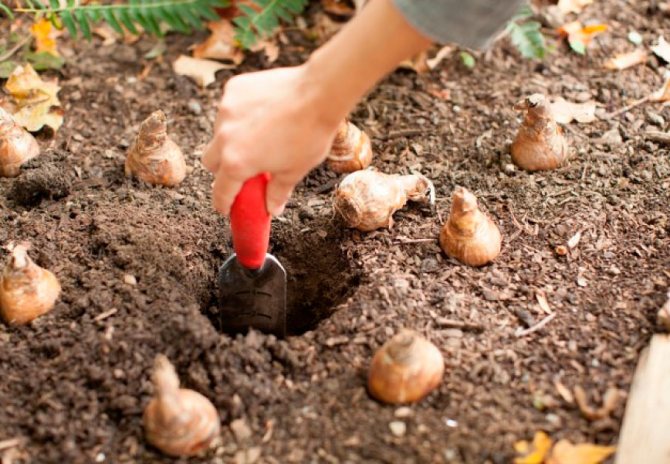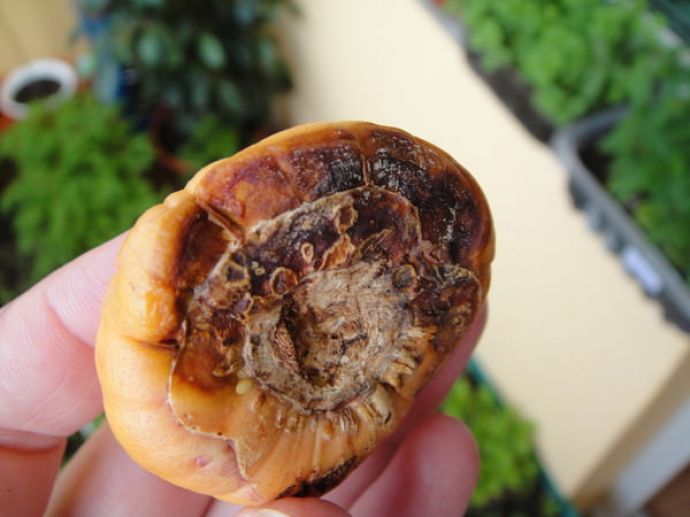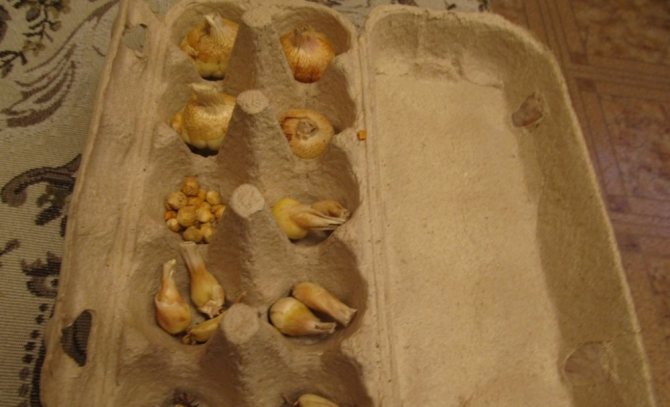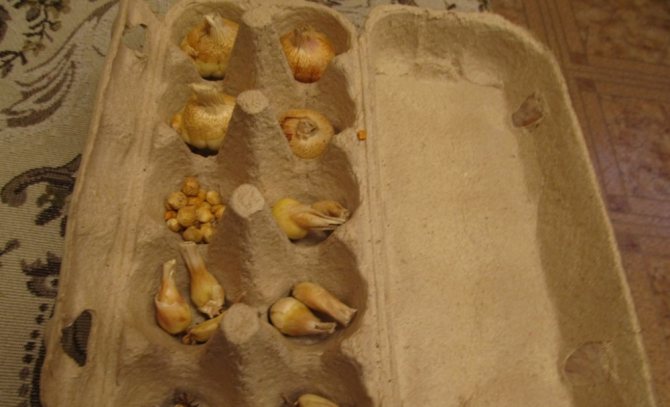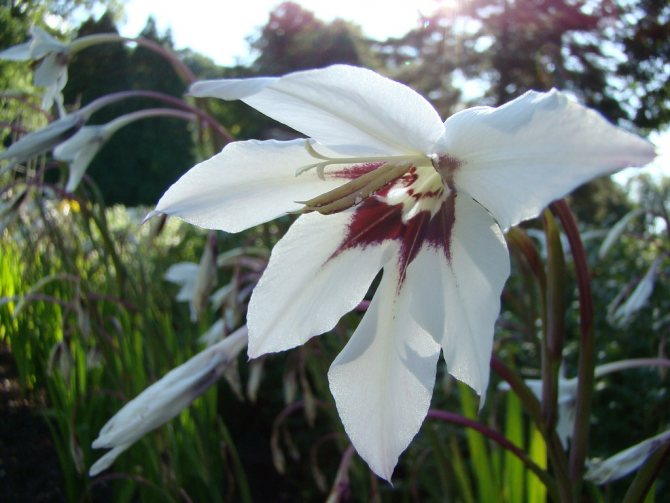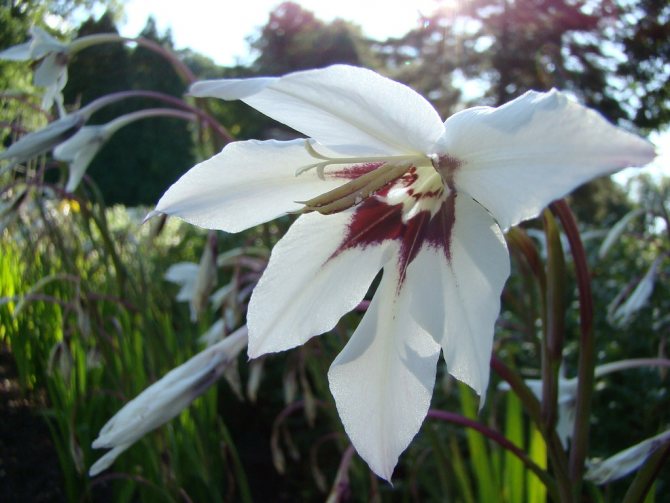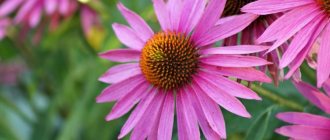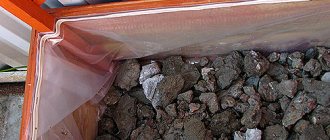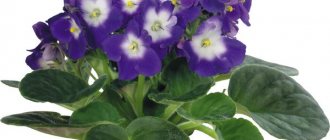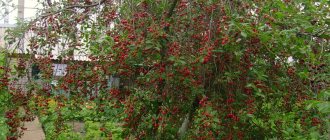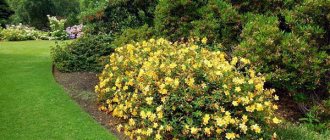Acidantera is a plant from the iris family, which is a distant "relative" of gladiolus. These flowers with delicate petals and a delicate aroma are native to Africa, and in translation from Greek the name sounds like "sharp flower". It got this name because of its pointed petals.
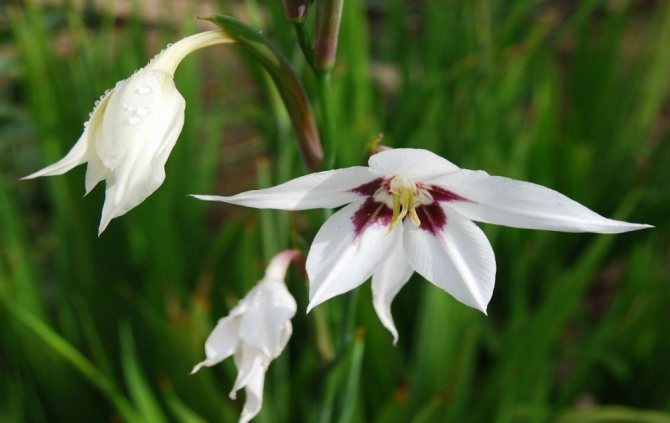
The people also have another name for this exotic handsome man, “fragrant or wintering gladiolus”. Plants do have some external similarities.
Corm storage
In the fall, it is imperative to dig up the acidander. This should be done in October. If this rule is disregarded, then the acidander will most likely freeze or become very weak. Dug out bulbs must be dried.
After 3-4 days after digging, old bulbs and rhizomes are separated. You should not do this right away, because during separation there is a risk of damage to the bottom. Already processed bulbs are stored for a month in the warmest place of an apartment or house. For example, on the top shelf of a kitchen cabinet. This will prevent further decay. For preventive purposes, to combat diseases and pests, tubers should be treated with fungicides.
In winter, the corms are stored at a temperature of 4-6 degrees. If the amount of planting material is small, then you can wrap it in paper, then in a plastic bag and put it in the refrigerator. Bulbs can dry out at room temperature. In this case, you can use the following method: the tubers are placed in a three-liter jar, filling it halfway so that there is enough space for air, and covered with a plastic lid. You can additionally make two or three holes in the cover
Acidantera growing from seeds
Areca chrysalidocarpus features of care and cultivation
Acidantera can be propagated by tubers (bulbs), babies and seeds.
The seed method is used very rarely, this is due to the fact that it takes a very long time to wait for flowering from such specimens. The seeds are harvested in the fall or purchased from flower shops.
Sowing seeds for seedlings is carried out in February. To do this, over the pre-calcined earth (warm it up in an oven to get rid of bacteria and parasites), seeds are sown and sprinkled with a small amount of soil, moistened and covered with foil or glass.
Ventilate from time to time and, if necessary, humidify with a spray bottle. The optimum temperature of the content is + 20 ... + 24 ° С. In two to three weeks, friendly shoots will appear, which dive into small pots, in which they will grow for two to three years, until the tuber grows to such an extent that it can provide flowering. After the first flowering, young seedlings can be safely planted (in the spring) in open ground.
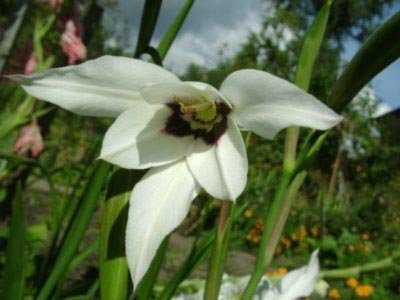

How to store in winter
Vallotta. Features of home care
It is best if the bulbs are stored in a dry basement or cellar. Storage of planting material should be separate, as far as possible away from vegetables and fruits.
But if this is not possible, they need to be stored on the bottom shelf in the refrigerator. It is better to put them away for storage in a paper bag with holes.The temperature for storing gladioli bulbs should be between 4-8 ° C. The moisture that will evaporate from vegetables and fruits is harmful to the selected planting material.
Ideal if the humidity is around 80%. For children, you need to create slightly different conditions. It will be better if they are stored in a room with a temperature of about 3 ° C and a humidity of almost 90%.
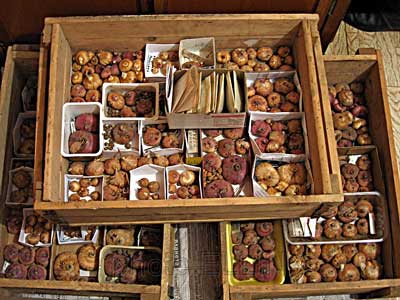

Storing gladioli.
Storage after digging gladioli bulbs should be in special boxes with a mesh bottom. This will enable them to be sufficiently and evenly ventilated. Containers with planting material are installed on special racks.
If there are no special storage containers, you can let the gladioli spend the winter in boxes of sand. In the sand, the tubers will begin to grow overgrown with children.
Another option is storage after digging in nylon bags. The bag must be tied to the rack so that it is ventilated from all sides. You can put a few peeled garlic cloves nearby to protect and prevent diseases.
Periodically, from time to time, the bulbs need to be removed and revised. Even if all bulbs are reviewed for infection before storage, it is better to additionally revise and check them. It is better to destroy a sick or suspicious specimen.
During the dormant period, new buds are laid in the bulbs, which will give life to new shoots. Before sending the bulbs for storage, they must be treated with special solutions to prevent infection with thrips and viruses. After treatment with a solution of laundry soap, potassium permanganate sludge, the future planting material is treated with preparations of your choice: Inta-vir, Maxim, Hom.
It is difficult to save bulbs without a cellar. To store them, you will need to create additional conditions with special care. The planting material must be folded in paper bags or folded into a cardboard box, sprinkled with sawdust, and then find the coolest place. Most often this is the bottom shelf of the refrigerator. It is necessary to make sure that the bulbs do not touch each other.
After winter storage, the bulb often loses noticeably in volume and weight. But after soaking in growth stimulating preparations and good care, a healthy and strong flower will grow from the bulb.
Preparing acidants for winter
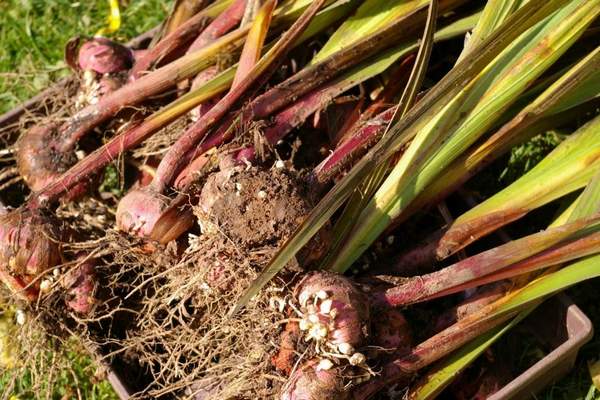

After the end of flowering, the tubers are prepared for the upcoming wintering. To do this, cut off the upper part, remove faded inflorescences. It is necessary to dig the bulbs out of the soil before the onset of winter frosts. The optimal time for digging is early - mid-October. For regions where cold snaps occur earlier, flower growers recommend removing corms from mid-September. For regions with a mild warm climate, it is not necessary to dig an acidander for the winter. With the arrival of autumn, the soil is mulched with peat or straw, spruce branches, cardboard boxes are laid on a flower bed. With the arrival of springtime, the shelter is removed, and the care of the plants continues according to the above scheme.
Digging is carried out with utmost care so as not to injure the bulb by accidental movements. Together with it, part of the soil is removed; it is not necessary to completely separate it from the rhizome. The dug tubers are laid out on a newspaper sheet and left to dry from moisture for several weeks. The room temperature should be at least 20 degrees Celsius, and the humidity should be minimal. It takes about a month to completely dry, maybe a little more.
Dry soil is removed from the dried corms, wiped with a dry cloth. For better storage, the planting material is treated in a fungicidal solution. They prevent the formation of mold, rot on the bulbous scales, which means that there is no need to worry about their condition. After treatment with fungicidal agents, the bulbs are dried again, and then dry scales are removed from them.During storage, the plants rest, gain strength before the next flowering until spring.
Soil preparation and planting
Features of home care for the Radermacher flower
Planting an acidander flower and caring for it does not cause any particular difficulties, but nevertheless, some nuances must be taken into account.
The soil should be neutral or slightly acidic. If the soil is too acidic, it will be limed.
Do not get carried away with abundant watering, since the tubers of the plant are prone to decay. To ensure moderate soil moisture, it is recommended to cover the soil surface with a layer of peat after planting the plant. Before planting, it is necessary to fertilize the land with mineral and organic fertilizers. Rotten leaves, humus, old sawdust are suitable for this purpose.
In order to speed up the flowering of acidants, some growers prefer to germinate the plant in pots first. Sowing should begin in March, and when the frost ends (end of May), you can start planting seedlings in open ground. Such sprouted tubers are planted shallowly into the ground (no more than 5 cm).
Two weeks before planting, the bulbs are taken out of storage so that they are thoroughly warmed up. Then they are sorted by size, discarding the rotten and spoiled ones. A healthy bulb is usually milky, dry, covered with a light brown shell. To protect against pests, the bulbs are soaked in a weak solution of potassium permanganate before planting.
Corms are planted in prepared holes. If group plantings are required, rows are made. The planting depth is 8-12 cm, and the distance between the holes should not be less than 20 cm. If the planting material is used as planting material, the planting depth is approximately two bulb diameters.
Using
The adorable acidander can be used in a lush flower garden or in a group planting in the middle of a lawn. Large and unusual flowers will attract passers-by and delight the owners of the site. With the help of acidantera, you can arrange a rock garden or the banks of artificial reservoirs. Flowers are good not only in the garden, but also in flowerpots.
The plant is widely used as a house flower. It should be noted that in a small room the smell can be too intense, so during the flowering period it is better to put the flowerpots on the balcony or veranda. Acidantera also behaves well in the cut. Each peduncle carries several buds that open gradually. The bouquet will stand in a vase for at least a week.
Post Views: 4
Types of acidants
There are more than 40 species of acidantera in total, but since it is a thermophilic plant, not all varieties can be cultivated by flower growers in Russia. The most common types of this plant can be characterized as follows:
- Acidantera bicolor. The basic view, which has gained wide popularity. Another name for Acidantera murielae or Gladiolus Muriel. The plant reaches a height of 1.2 m. The flowers of Acidantera Muriela, up to 12 cm in diameter, are white in color with purple veins and a greenish spot in the throat.
- Acidantera tropical. The height of the plant is just over a meter. The inflorescences are pale pink in color. There are bright crimson spots along the edges of the corolla.
- Acidantera White. It is characterized by snow-white flowers without any blotches. Very strong aroma.
- Cereal-leaved acidantera. The leaves are long and narrow, and the flowers are pale pink with red veins from the center to the edges.
- Short-tubular Acidantera. The corolla is bright purple with shimmering burgundy stripes that look like a candle flame from a distance.
To a florist on a note about acidander, photo
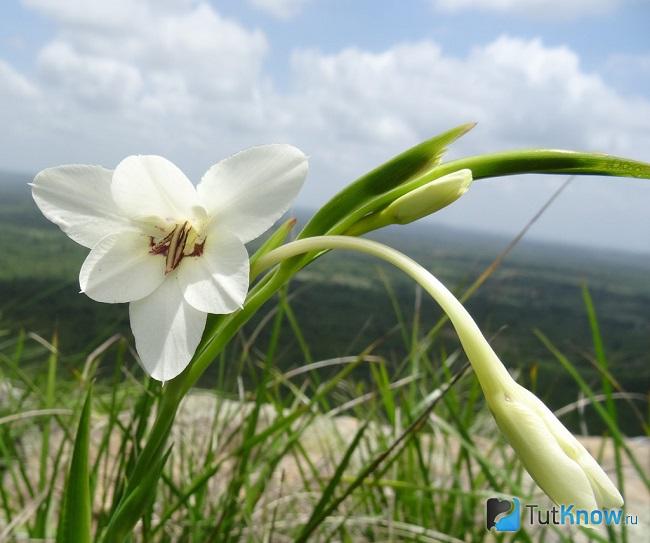

A variety of Muriel's acidantera can be found under the name Muriel's Gladiolus or Muriel's Skater.All because of its resemblance to gladioli, as well as its delicate aroma, the plant is called "fragrant gladiolus" This type of acidantera became available when a breeder from England Calvey offered to put the plant on sale in 1885 under the name Gladiolus murieli.
Description of Acidantera
Photo: Acidantera
Family of iris. Name: comes from the Greek words acidos - sharp and anthos - flower, given in the form of pointed perianth lobes.Description:
the genus unites about 40 species common in tropical Africa. Corm perennials, resembling gladioli in appearance. Stems are erect, slightly leafy. Leaves are linear or narrow-shaped, dark green. The flowers are large, 7-9 cm in diameter, very graceful, with a delicate aroma, white, pink, yellowish or light purple, with a long bent tube and pointed, almost equal lobes, collected in an inflorescence - three to six-flowered spike. The corm is round, milky white, about 5 cm in diameter, covered with a dense light brown reticular membrane. The fruit is an elongated capsule. A. bicolor is the most widespread in culture.
Location:
photophilous, require sunny locations. Typically, acidants are grown in greenhouses; in the south, they can also be cultivated outdoors.
The soil:
should be well-drained, light, horticultural, fertile and slightly acidic.
Landing:
corms are planted in the spring in the ground to a depth of 8-12 cm and a distance of 12-20 cm, depending on their size. For earlier flowering, acidander is grown in pots since March. In a pot with a diameter of 12-15 cm, 3-6 corms are planted to a depth of 3-4 cm. They are kept in a greenhouse, a warm greenhouse or on a light windowsill, at the end of May they are planted in place in the garden. Plants are more vigorous, bloom more abundantly and last longer.
Care:
usual - watering, feeding, mulching.
Reproduction:
seeds, corms and children. There are a lot of children on the plant. They are grown on a special ridge; with intensive care, large children bloom in the first autumn. It is easy to propagate by seeds. Sowing is carried out in winter. No stratification required. Seedlings develop quickly and are suitable for planting in open ground by summer. Since Acidantera does not like damage to the roots, from the moment of picking to planting on the street, seedlings are grown in pots. Flowering occurs in 1-2 years.
Storage:
at the end of flowering, the stem is cut off, leaving the lower leaves. With the onset of frosty weather, the plant is dug up, the aboveground part is cut off, the corms are dried for a month at 20 ° C, cleaned of roots and excess scales, placed in paper bags made of loose paper and stored at 15-16 ° C. When stored in colder conditions, the corms fall asleep.
Using:
Acidantera is suitable for prefabricated flower beds or individual plantings in groups, it can be planted in outdoor pots or containers. In the latter case, she will need enhanced watering and feeding. Acidantera is more suitable for flower decoration than gladioli, it is more graceful and delicate and smells great. It is widely used for cutting, but the aroma is too strong for a small room.
Growing acidantera in the garden how to plant and care for a flower
For planting and caring for acidander flowers in the garden, it is better to take a sunny place with these plants, in extreme cases, light partial shade. In the shade, flowering turns out to be weak, sometimes completely absent. Although the peduncle of the plant is strong and rarely needs tying, it is better to plant it in places protected from the wind. Not demanding on soils. In addition to heavy clay soils, it can grow on almost any soil, including shallow soils. Suitable for planting in containers, and can be grown as a houseplant.
The ideal time for planting is from late April to late May. Grows well in moist, drained soils.The topsoil should never dry out. But pouring is as harmful as not adding, and here you must observe the measure. Stagnation of water in the soil is especially dangerous, from which its corms can rot. The best flowering in the garden can be obtained when grown in light, fertile, well-drained soil of a slightly acidic reaction. Therefore, before planting, the soil is dug up and well filled with organic and mineral fertilizers.
Corms are planted in open ground after the threat of frost. However, when planting this thermophilic plant in late May - early June, it is not always possible to achieve full flowering. In a cold and rainy summer, it may not bloom at all.
They are planted in the ground to a depth of 8 cm, depending on the size of the corms, leaving a distance of 12 cm between the plants. He loves moisture, therefore, in summer, especially in hot weather, he needs good watering. Since the beginning of flowering, watering is somewhat reduced.
Once every two weeks, they are fed with quick-dissolving complex fertilizers, combining top dressing with watering. To prevent moisture evaporation, the soil is mulched using the usual methods: peat, humus, cut grass, etc. Mulching also helps prevent weeds. During the growing season, they monitor diseases (rust, powdery mildew, root rot, wilting, mosaic) and pests (thrips, aphids, spider mites, slugs) that can affect plants.
In the event of these problems and for their prevention, drugs from the store are used. After flowering, the peduncles are cut off so that the corm can ripen.
To extend the growing season, acidants when grown in the garden and to protect them from spring or autumn frosts, during these periods the flowers are covered or containers are transferred to a warm place.
Before planting the acidander in the ground, the bulbs can be grown in containers. This ensures a lush and long-lasting bloom during August and early September. The corms have time to store enough nutrients for flowering next year. In March, the corms are taken out of storage and placed in the light at room temperature so that they start to grow and give an arrow.
After that, the corms are planted in pots with soil and grown until April on the windowsill. In mid-April, pots with seedlings can be transferred to a loggia or a greenhouse, and in May they can be planted in warm soil or in containers along with a lump of earth from the container so as not to disturb the roots.
Here you can see a photo of planting and caring for acidander flowers in your personal plot:
Propagated by seeds, corms and children. There are a lot of children on the plant. They are grown on a special ridge; with intensive care, large children bloom in the first autumn. It is easy to propagate by seeds. Sowing is carried out in winter. No stratification required. Seedlings develop quickly and are suitable for planting in open ground by summer. From the moment of picking to planting on the street, seedlings are grown in pots. Flowering occurs in 1-2 years.
Origin and varieties of acidantera
Native to southern Africa, Acidantera is ideal for growing in a tropical, humid climate. Forms elongated leaves up to 2 m high, produces a tubular stem, at the end of which there is a spike-shaped inflorescence with 2-3 simultaneously blossoming flowers. The flower of the acidantera is milky or creamy, fragrant, very graceful with dense petals and a burgundy spot in the middle. The root system is represented by bulbs 2.5 cm in diameter.
For cultivation, hybrid varieties are used, which are obtained by crossing wild acidantera with gladiolus.
The flower is thermophilic, therefore it is used for growing in the open field of the southern regions. In cold regions, acidander should be planted in a greenhouse or grown on a windowsill at home.
In nature, there are more than 40 species. Acidantera two-color (bicolor) is most widespread in garden plots. The history of cultivation of hybrids begins at the end of the 19th century. Acidantera bicolor is cultivated as an annual plant - before the frost the bulbs are dug up, they are planted again in the spring.
The main types of acidantera:
- two-color (bicolor);
- short tubular;
- tropical;
- white;
- Cape;
- Fourcade;
- Muriel;
- cereal;
- few-flowered;
- pink and white;
- broadleaf;
- tubular.
Acidantera bicolor for breeders is of great interest, since some species are poorly studied, and there is a huge amount of material for creating new varieties. Popular varieties for growing from seed are:
- Fragrant tobacco 578;
- Chanel;
- Nymph-535;
- White;
- Fragrant Etude 563 and others.
Possible diseases and pests and methods of dealing with them
Acidantera in a suburban area can be devoured by pests such as snails and slugs. Therefore, before planting the plant, the bulbs must be carefully treated with fungicides, which will also protect the plant from dry and soft rotting in the future.
The first sign of decay is dark, close to the color of rust, spots, which are most often located on the leaves of the flower. Having found such a spot, the affected leaf must be removed.
In addition to pests, the flower can become infected with a variety of viral infections. Therefore, the soil must be systematically fertilized with special dressings that protect it from microbes, and the leaves must be treated with antiseptic agents.
Landing rules
Fragrant gladiolus is a thermophilic plant, so in the southern regions it can be grown outdoors in an area with sufficient light. In other regions, it is recommended to grow acidander in greenhouses.
Corms need to be planted in the spring. For earlier flowering, you can plant the bulbs in flower pots in March. At the end of May, sprouted bulbs can be planted in open ground or in a greenhouse, adhering to the rules for caring for acidantera.
When planting, it is recommended to first treat the bulbs with fungicides to protect them from disease and decay.
Reproduction
Acidantera can be propagated by seeds and babies.
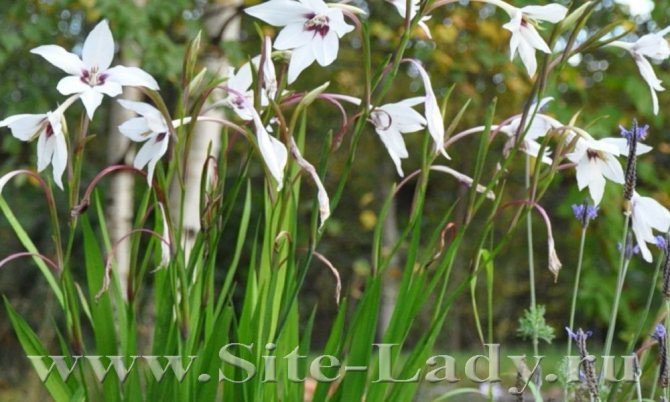

When propagating by seeds, you need to be patient, because this process is quite long and the first flowering will occur in a few years, depending on the growing conditions.
When breeding by children in early spring, you need to plant them in a container with nutritious loose soil. Care consists in weeding, loosening and watering regularly. After 2 years, small tubers are formed. They can already be planted in open ground or in a greenhouse.
Care
This flower does not like waterlogging of the soil, so you need to water it as it dries.
Loosening is carried out once a week. But it is desirable to feed with mineral fertilizers once every 2 weeks.
After the flowering is over, you need to cut off all the flower stalks. Leave the lower leaves to feed the tubers. Reduce watering, stop feeding.
Preparing for winter
Before freezing, corms are recommended to be dug up, cleaned from the ground, and the stems and children separated. The tubers must be well dried and left in a room where the air temperature does not exceed +22 degrees.
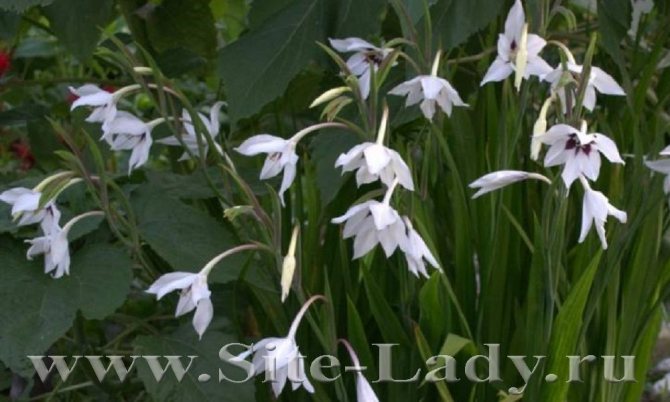

After complete drying, after 2 - 3 weeks, peel the bulbs of scales, each bulb must be individually wrapped in a napkin, folded into a paper bag, in which holes must be made for ventilation and taken to a dark place.
In the storage room, the temperature should be around +15 degrees.
Diseases and pests
With improper storage, as well as with waterlogging of the soil in which the acidantera grows, the plant can be affected by root rot.
Therefore, it is very important to ensure that there is no dampness.
Snails and slugs often visit this plant. They must be collected from the plant and carried at a distance farther from the flower.
When aphids or spider mites appear on the plant, it is necessary to spray with insecticides.
Garden flower on "A", 10 letters.
Reproduction
The acidantera flower, similarly to gladiolus, can multiply by seeds, bulbs (corm babies). Let's consider each of the methods in more detail.
Seeds
The method is rarely used, since the flowering of the plant will have to wait for a very long time. Its scheme is as follows - at the end of March, the seeds must be planted in a fertilized, mineral-rich loose soil, and sent to a room with a temperature of 20-25 degrees. Of course, the seedlings must be constantly monitored.
Bulbs
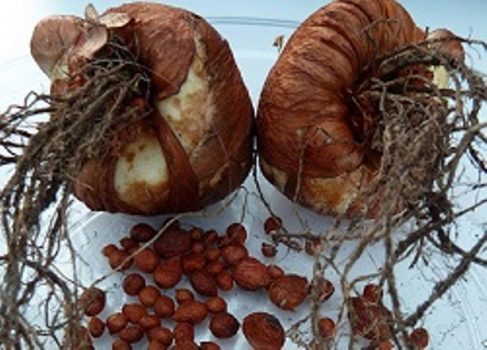

Many babies form on the bulbs. In the spring they need to be planted in grooves or containers with loose soil. Systematically you will have to do weeding, add water, and loosen the soil. After a couple of years, nodules will grow, which can be transplanted to a permanent place.
Plant care basics
During the engraftment period, the plant is regularly watered, but not very abundantly. Drought negatively affects growth and flowering, and excess moisture provokes decay of the root system.
The soil must be light and air-permeable, so after each watering it must be loosened to prevent the formation of a crust on the soil surface. For this purpose, mulching should be carried out using peat, dry grass, humus or sawdust. It is imperative to promptly and thoroughly remove emerging weeds so that they cannot drown out the young plant.
The bulb from which the acidander grows is gradually depleted, and therefore the introduction of additional nutrition is extremely necessary for the development of the root system, the aerial part of the plant and the establishment of flower buds. At the initial stage of development, it is recommended to feed with organic (mullein solution, bird droppings) and mineral fertilizers. During the period of enhanced growth, nitrogen-containing complexes are used, and during the formation of flower buds and the development of buds, it is recommended to apply phosphorus-potassium fertilizers.
Reproduction of acidantera is done in three ways:
- Seeds. This is a rather long process, flowering can be expected only in the third year after sowing the seeds. Therefore, gardeners prefer other ways of breeding acidants.
- Reproduction by corms. The most effective way, as the plant blooms in the first year of life.
- Reproduction by "children". In this case, flowering in the first year is not expected, although some experienced growers claim that proper and careful plant care works wonders.
Features of outdoor care
Watering
Bulbous plants do not tolerate excess moisture, flowers immediately shrink, bulbs rot, but they also do not want dryness. Water your flowers regularly as soon as the soil is dry. For irrigation, use water that has already settled during the day and has become soft and warm. Water not fanatically, but thoroughly.
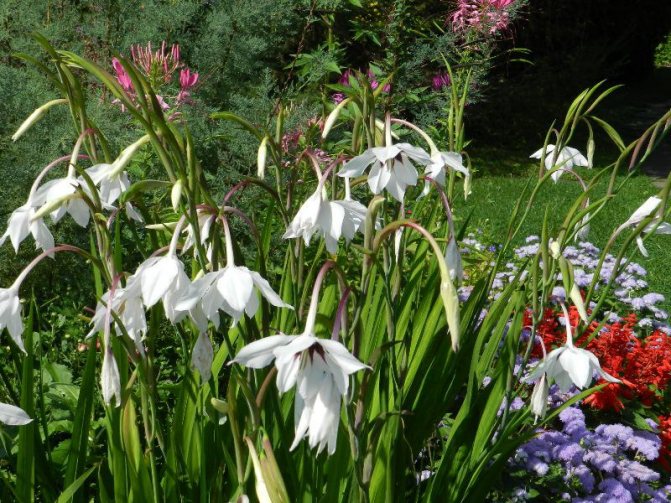

Loosening
You always need to loosen the bulbous ones. Whether you watered the plot or it rained, you have to loosen the beds the next day. Otherwise, you can provoke the appearance of pathogenic flora, decay, and attract parasites. But be careful, as the bulbs are located close to the surface, do everything very carefully.
There is no extra time for weeding, watering, weeds, then mulch the area with decorative chips - simply and very decorative.
Weeding
Everything is clear here - if there are weeds, then there are parasites, excess moisture, diseases. Climbing weeds suck up juices, so always keep it clean. Remember only - the bulbs are close. No time - mulch can help you.
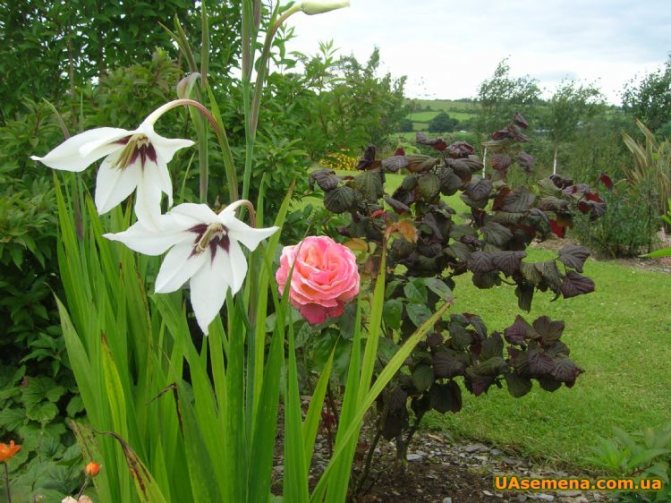

Top dressing
Experienced summer residents say that acidantera, a herb for open ground, responds well to feeding.For abundant flowering, for large flowers and bright greenery, mineral complex preparations with phosphorus and potassium can be used - every 7-10 days. Root dressing is applied in the evening or early in the morning. You can use all the same superphosphate, "Universal", liquid complex dressings that are in every store.
Top dressing from.
When to dig
The time for digging up gladioli in the middle lane begins in the second half of September and lasts until the time when constant autumn frosts begin
It is important to take into account the fact that at least 40 days should pass after flowering. Only by this time will the bulb fully mature
How to tell when to dig up gladioli? You need to check for the plant itself. Whether the bulb is ready for digging is determined by the ground part of the gladiolus. If the leaves have withered and turned yellow, you can start. It is better to start by digging out the bulbs of varieties with dark colored petals (red, cherry, purple). Dark varieties are usually weak and vulnerable to fungal infections.
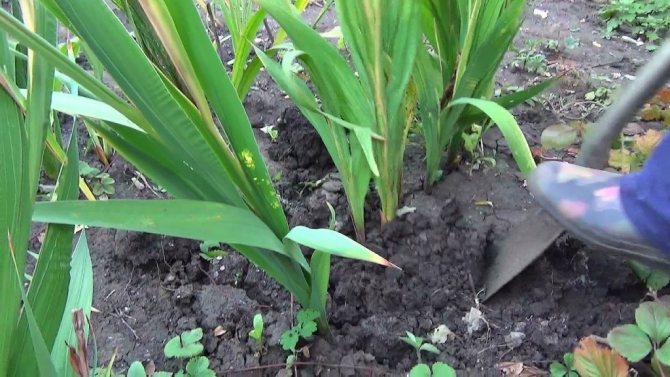

Digging up gladioli.
The last to be dug up and stored should be gladioli, which were grown from the "kids". It will be better if the digging takes place in dry weather. The dry soil will not adhere strongly to the bulbs. It is also easier to get all the children out of dry soil. Children "lost" in the ground will overwinter and in the spring they will "mix" the varieties in the flowerbed. This is undesirable.
If it is necessary to harvest the bulbs in the rain, they must be rinsed in running water and be sure to dry thoroughly.
After all the bulbs have been dug out, they must be "cut": cut off the roots, stems. Carefully, so as not to damage the bottom of the substitute bulb, the old bulb must be removed. After that, all corms are processed as a preventive measure after digging. A weak solution of foundation is used, a pink solution of potassium permanganate. The bulbs are immersed in a container with a solution and kept for about half an hour.
If the gladiolus has been affected by insects or fungi, the bulbs must be burned. This is the only way to stop the spread of the infection.
After a preventive bath, the gladiolus bulbs must be thoroughly dried. Drying them at room temperature (22-23 C) lasts about a month. The bulbs should be laid out in one layer on a linen surface.
If possible, it is better to speed up this process with improvised means. To do this, you can use a hair dryer, special dryer or other heating device. If there is a danger of infection with a fungus, forced drying will prevent the disease from developing.
Biological characteristic
The name "acidantera" comes from the Latin acidanthera, which means acidos - sharp and anthos - flower. The plant got this name because of the pointed petals. Some growers call the flower "fragrant gladiolus" because of the extraordinary aroma emanating from the plant during flowering.
Acidantera is a herbaceous bulbous perennial belonging to the Iris family. The underground part is represented by corms measuring 5-6 cm in diameter and having an oblong shape. The stem is erect, reaching a height of 1 meter. Leaves are narrow and long, mostly located at the base of the stem. There are quite a few of them on the upper part of the shoot.
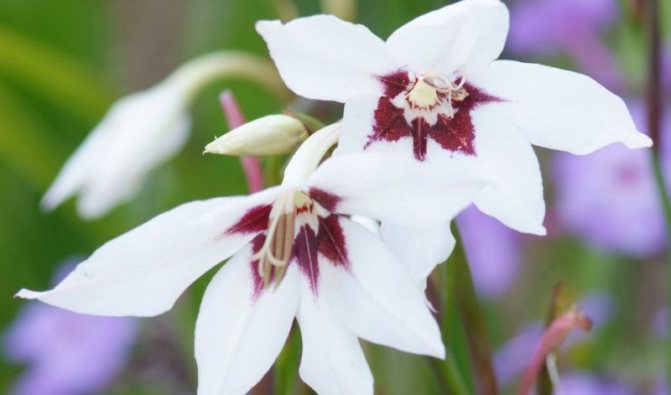

The color spectrum of inflorescences is very diverse: light lilac, yellow, pale pink, cream, milky. Acidantera blooms at the end of summer and continues to delight until the first frost. Then an elongated seed capsule is formed, filled with small seeds.

